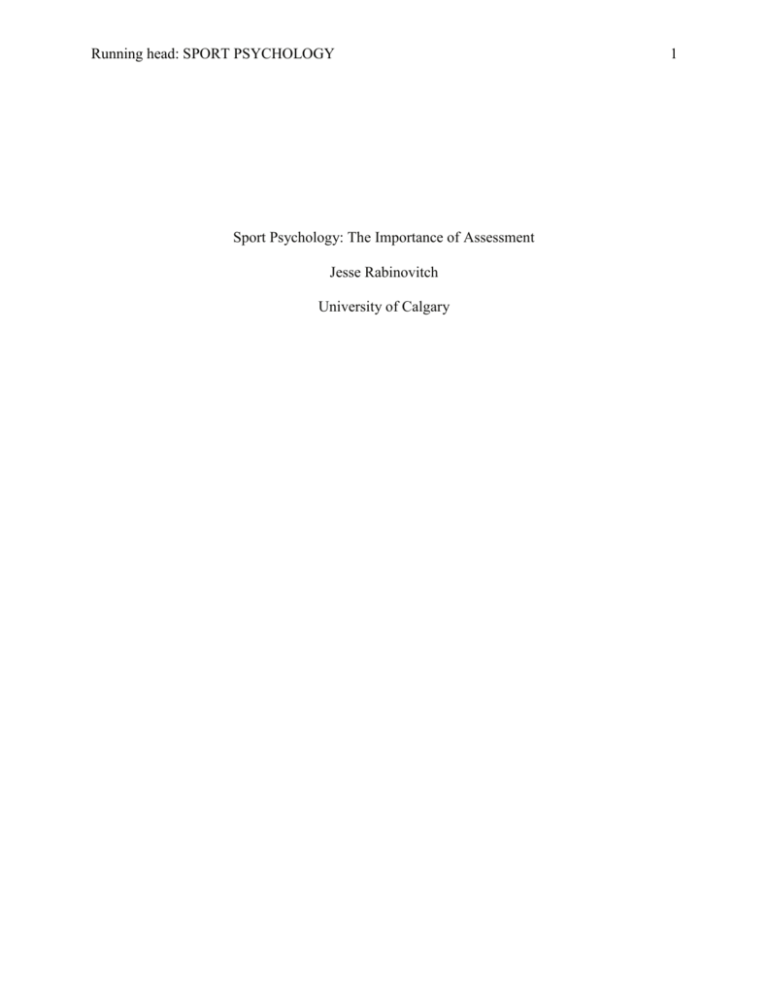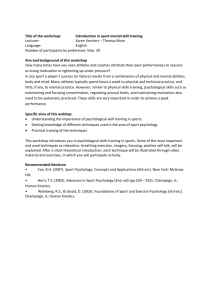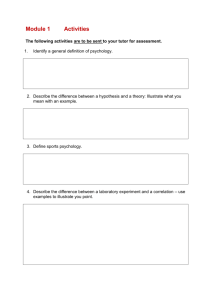File - Jesse Rabinovitch's Portfolio
advertisement

Running head: SPORT PSYCHOLOGY Sport Psychology: The Importance of Assessment Jesse Rabinovitch University of Calgary 1 Running head: SPORT PSYCHOLOGY 2 Sport Psychology: The Importance of Assessment Counselling is often thought of as a discrete and straight forward process catered to clients’ needs. But what helps practitioners decide on the direction that they choose to undertake in their work with clients, and eventually an intervention to implement? The answer is assessment. The use of ongoing assessments with clients can greatly facilitate the answers to these questions; however, acquiring solid data from clients is not always as simple as sitting them down and asking a list of generic questions in an effort to gain an understanding of their worldview and the particulars of their situation. The use of assessment in counselling is employed to attain an objective measure of clients’ strengths and weaknesses. Information regarding the identification of one’s problems, coping mechanisms, and resources can all assist in developing effective interventions which yield long-lasting results (Ravizza, 1988). Essentially, there are two components of the counselling relationship that have an indirect effect on one another: assessment and intervention. Assessment refers to the explorative part of counselling where information about clients is obtained. Whereas intervention refers to the modifying part of the therapeutic alliance where behaviours, responses, and cognitions can be changed (Anshel &Wells, 2000). Ultimately, assessment serves to inform the intervention process. Use of Assessment in Sport Psychology Psychological assessment in applied sport psychology is certainly an extremely controversial issue. Due to the lack of evidence supporting substantial gains stemming from the use of psychological testing amongst athletes, many people in the field have avoided investigating its potential value (Ravizza, 1990). In the past, psychologists working with teams and individual athletes did not heavily rely on the use of assessment as a means to guide their practice, and as a result had their efforts fall short (Brawley, Carron, & Widmeyer, 1987). More recently, Running head: SPORT PSYCHOLOGY 3 psychologists are employing numerous formal and informal measures to attain objective information regarding athlete populations from the outset of counselling. Current sport psychology literature notes that some commonly used assessment measures include psychological interviews, systematic observation of athletes, coaches, and team behaviour, as well as psychological tests (Beckmann & Kellmann, 2003). Kellmann, Altenburg, Lormes, and Steinacker (2001) note that by gaining sufficient objective data they were able to use assessment as an instrument to guide their work with Canadian rowers and as a result were able to achieve successful outcomes both with the team and individual athletes. Using assessment to guide psychological work with athletes is something that is proven to yield helpful results. Integrating objective information collected by practitioners into their work with athletes is likely to promote the implementation of effective interventions that suit clients’ needs. Due to the limited success that sport psychologists had in the 1990’s (Dorfman, 1990; Halliwell, 1990), many researchers have focused on what makes some sport psychology interventions more successful than others. Much of the current research supports using a problem-focused assessment as the starting point for any sport psychology work (Kellmann & Beckmann, 2003). Rather than bombarding athletes with heaps of questionnaires, practitioners should avoid using assessments that do not focus on specific situations. Taking a deliberate methodical approach to working with athletes is what seems to be the most effective. Assessment should always remain problem-oriented and support the selection and implementation of solutions to the client’s problem. For instance it would not be appropriate to test the eye-hand coordination of an alpine ski racer; whereas, this would be acceptable when working with a struggling basketball player. Following the identification of a client’s problem, the practitioner should focus on building his/her client’s confidence in the therapeutic process through trust Running head: SPORT PSYCHOLOGY 4 building measures (Andersen, 2000). Building a strong sense of rapport with clients can facilitate further work such as diagnosing group processes, assessing athletes’ personalities, and current psychological states. Prior to getting the cooperation of athletes and coaches for assessment processes, they should have confidence in the psychologist’s competence, that he/she is trustworthy, and that there is an advantage to engaging in on-going assessments. Keeping the client’s goals in mind during counselling, and not wasting time with unnecessary assessments is a practice that will save time, patience, and amount to clients having a higher level of trust in one’s competency as a counsellor. The Importance of Personality Psychologists working with athletes must be aware of the different psychological processes that athletes engage in. In an attempt to facilitate this, many assessment instruments in sport psychology focus on the individual differences of certain characteristics (Beckmann & Kellmann, 2003). Some of these characteristics include achievement orientation, concentration skills, and anxiety. Sport psychology interventions can be useful for identifying the individual differences within a team, helping the coach to better understand his/her athletes’ individual behaviours, and placing certain events or positions in teams. Taking an isolated look at single individual characteristics is often insufficient to find adequate solutions to athlete’s problems. Examining an athlete’s personality is important to understand how they fit in with their team environment. Phares (1991) defines personality as “the pattern of characteristic thoughts feelings, and behaviours that distinguishes one person from another and that persists over time and situations” (p. 4). For a complete understanding of individual athletes’ behaviours, one has to gain insight into their personality. Before turning to individual assessments it is important to assess group constructs such as team cohesiveness and team cohesion (Brawley et al., 1987). An Running head: SPORT PSYCHOLOGY 5 understanding of the initial problem situation is enhanced through insights into the group level processes. Examining group processes may reveal that some athletes are not finding the appropriate position for within their team environment. An examination of athletes’ personalities may further reveal information about where they would be better suited to fit in (i.e. playing on a different line, or at a different position). Thus, fitting athletes into the team environment correctly may be one of the many useful outcomes of employing effective assessments aimed at understanding personality. Standardized Assessments Beginning with informal psychological measures, such as observations or non-structured interviews, is often an advantageous way for sport psychologists to initiate their work with athletes. This serves the purpose of enabling psychologists to attain a solid data foundation without forcing their clients to provide them with information. Kellmann and Beckmann (2003) suggest that following the collection of sufficient data, practitioners can begin to use more formal measures as a means to customize their work with athletes and cater to their unique needs. The most formal assessment instruments are standardized tests. Using more formal measures facilitates a practitioner’s ability to make comparisons between individuals and to relate a particular situation to more general theoretical knowledge in sport psychology. Doing so enables practitioners to base their work on appropriate interventions that have proven to be successful in such situations (Tobar, 2005). Although the use of standardized tests with athlete populations can significantly enhance one’s work, practitioners need to remain aware of these tests’ psychometric properties. Duda (1998) notes that many standardized instruments that sport psychologists use in practice are not normed on athlete samples. This can be very misleading for psychologists working with athletes because athletes often show different scores compared to the Running head: SPORT PSYCHOLOGY 6 norms of non-athletes. Furthermore, there are also large individual differences between different athletes (Brawley et al., 1987). Psychologists working with athletes must exercise caution when selecting assessments and utilizing them with certain populations as a means to draw comparisons. Understanding how a test is to be used and why you are using it is essential in order to gain beneficial information from it and apply it to your work with clients. Reliability and Validity While it may seem beneficial to draw largely upon standardized assessments, practitioners need to remain aware of their potential to lead to misinterpretations. Reliability and validity of tests is another important factor to take into account when determining whether or not it would be an appropriate assessment to use. Halliwell (1990) notes that assessments with high reliability and validity often are the most useful in sport psychology. However, practitioners need to remain aware of their client’s needs. They should always keep the question of whether a test was created for use in individual therapy or more so as a measure for understanding the broader group behavior of a team in mind. Remaining vigilant of test psychometric properties is extremely important when administering assessments; however, sometimes sacrificing reliability and validity at the cost of gaining additional information is worthwhile. Practitioners must keep in mind that when tests have high reliability and validity assessed on a group level this does not mean that it will have the same reliability and validity for single athletes (Kellmann & Beckmann, 2003).The use of particular tests always depends on the purpose of the assessment. First, one has to gain an understanding of the requirements within a given sport and a basic understanding of the problem situation before testing instruments can be selected. Closing Running head: SPORT PSYCHOLOGY 7 The work of a sport psychologist can only be as effective as that of the practitioners themselves. Studies have demonstrated that by using sport psychology as an integral component of the whole coaching system is when it is most effective (Kellmann et al., 2001). Having athletes use mental skills training as part of their routine preparation is when it yields the most effective results. Athletes will see the greatest improvement in their performance over time; results do not occur instantaneously. Taking a multidisciplinary approach to administering assessments in sport psychology, where the psychologist is seen as a member of the team also enhances the effectiveness of sport psychology interventions (Tobar, 2005). This way a negative stigma towards the acceptance of working with a psychologist will be minimized. Having the support of other team member as well as the coaches can significantly improve athletes’ perceptions of using psychological assessment to their advantage. Using assessment as a means to guide one’s work with athletes has been demonstrated to be a crucial component of working as a sport psychologist (Beckmann & Kellmann, 2003; Kellmann et al., 2001). Outside of the actual assessment measures used with athletes they are many extraneous variables that come to influence the counselling process. In addition to the criteria mentioned in this paper, not losing sight of building rapport with clients and the context of the situation are also essential for achieving successful results with athletes as a sport psychologist. Running head: SPORT PSYCHOLOGY 8 References Andersen, M. (2000). Beginnings: Intake and the initiation of relationships. In M. Andersen (Ed.). Doing Sport Psychology (pp. 3-16). Campaign, IL: Human Kinetics. Anshel, M. H, & Wells, B. (2000). Personal and situational variables that describe coping with acute stress in competitive sport. The Journal of Social Psychology, 140(4), 434-450. Beckmann, J., & Kellmann, M. (2003). Procedures and principles of sport psychological assessment. The Sport Psychologist, 17, 338-350. Brawley, L. R., Carron, A. V., & Widmeyer, W. N. (1987). Assessing the cohesion of teams: Validity of the group environment questionnaire. Journal of Sport Psychology, 9, 275294. Dorfman, H. A. (1990). Reflections on providing personal and performance enhancement consulting services in professional baseball. The Sport Psychologist, 4, 341-346. Duda, J. L. (Ed.). (1988). Advances in sport and exercise psychology measurement. Campaign, IL: Human Kinetics. Halliwell, W. (1990). Providing sport psychology consulting services in professional hockey. The Sport Psychologist, 4, 369-377. Kellmann M., Altenburg, D., Lormes, W., & Steinacker, J. M. (2001). Assessing stress and recovery during preparation for the World Championships in rowing. The Sport Psychologist, 15, 151-167. Kellmann, M., & Beckmann, J. (2003). Research and intervention in sport psychology: New perspectives for an inherent conflict. International Journal of Sport and Exercise Psychology, 1, 13-26. Phares, E. J. (1991). Introduction to Personality (3rd ed.). New York, NY: Harper. Running head: SPORT PSYCHOLOGY Ravizza, K. (1988). Gaining entry with athletic personnel for season-long consulting. The Sport Psychologist, 2, 243-254. Ravizza, K. (1990). SportPsych consultation issues in professional baseball. The Sport Psychologist, 4, 330-340. Tobar, D. A. (2005). Overtraining and staleness: The importance of psychological monitoring. International Journal of Sport and Exercise Psychology, 3(4), 455-468. 9





